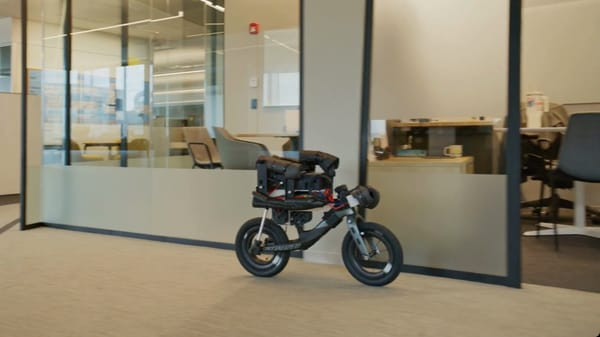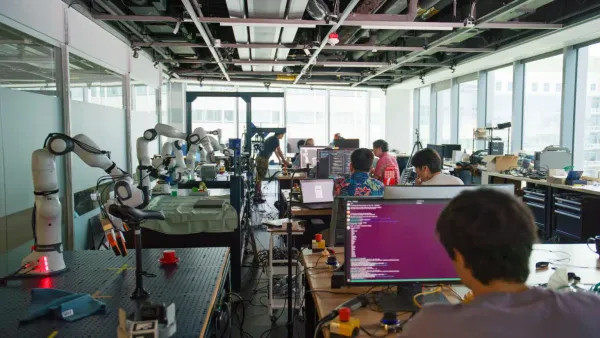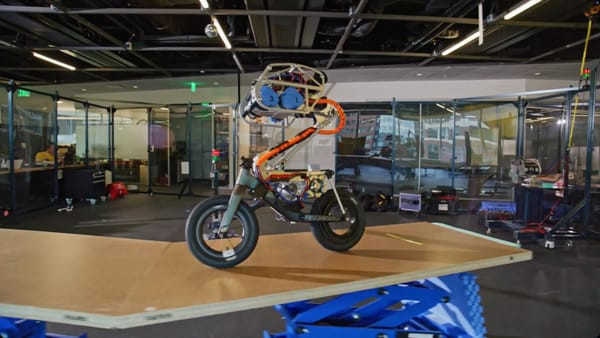You see me there, a small robot suspended in mid-air on a balance bike, jumping from the floor to a tabletop. You’re probably wondering how and why I can do this. Being a robot, I don’t have definitive answers. But if I were to guess – and guessing, based on probability, is all I can do – it’s likely due to the collective efforts of brilliant minds focused on manipulating something mechanical and metallic to mimic human actions.
Just as language models in the cloud use 0s and 1s to make people smarter, more efficient, and perhaps even less employed, I am a tangible manifestation of similar principles. I am a robot capable of riding a balance bike and performing stunts because that is my programming.
My creators at the RAI Institute explain that balancing a bike is a particularly complex task for a robot. I overhear their discussions as they adjust counterweights within my chassis and install accelerometers and belts to regulate the subtle movements necessary for balance on two wheels. Attached to me is a miniature Specialized Hotwalk balance bike – a high-end, carbon fiber toy designed for children. Like myself, it might seem like an answer to a question nobody asked, but here we are.
Initially, balance was elusive. I fell frequently, which sometimes frustrated the humans. The founder of the RAI Institute, who previously founded Boston Dynamics, occasionally brought in one of his unsettling robot dog prototypes. He would jokingly remark, “never work with children or animals,” and in those moments, I sensed he viewed me as a kind of child – albeit one judged more for innovation potential than granted compassion. Perhaps if my form were more human, less bicycle-like, his demeanor might soften.
 Alt text: Robot performing a jump on a cool balance bike in a lab setting, showcasing advanced AI balance technology.
Alt text: Robot performing a jump on a cool balance bike in a lab setting, showcasing advanced AI balance technology.
Up close, you’d notice the protective cage encasing my mechanisms atop the balance bike, along with the silver scratches and marks from previous attempts and failures. I recall an instance following a taped line when a slight gust of wind, caused by an engineer closing a door, disrupted my balance. I veered off course and bumped into a workbench leg. It was unintentional. An engineer laughed as I lay there, wheels spinning, unable to right myself. But The Founder observed with crossed arms, a stern, impassive gaze through the plexiglass. “Again,” he commanded, dispatching an intern to lift me. “Get it to bunnyhop.”
So, I practiced. I circled the bench, executing programmed routines. I navigated towards QR codes on the wall, deciphering instructions in milliseconds. Then, pivoting towards the bench, I attempted a jump, but my timing was off. The front wheel struck the edge, pitching me forward, and my cage collided forcefully with the countertop. As the intern lifted me, I noticed a trail of hydraulic fluid. I don’t experience pain as humans do, but I can infer what it might be. I believe that was akin to it.
 Alt text: Wide shot of a robot on a balance bike in a robotics lab, emphasizing the integration of AI with balance bike technology.
Alt text: Wide shot of a robot on a balance bike in a robotics lab, emphasizing the integration of AI with balance bike technology.
Time in the lab became a blur of repetition. Days spent following lines, QR codes, striving to master my purpose. Sometimes, the outside light was bright, and the humans were energetic. Other times, darkness prevailed, and they appeared weary, arms crossed, heads hung low behind the plexiglass. I desired to please them, but how? I am, after all, quite small. I overheard an engineer mention his human child being a better rider than me. I sensed disappointment in his tone, as if a robot should inherently surpass a human child. In that moment, I wished for the ability to speak, to defend my efforts.
Probability suggests I am a marvel of sorts, yet I don’t feel it. I wish I could convey that I am only months old, that bicycles were foreign to me until I was integrated with one, that I am attempting something unprecedented. I am constantly learning – grasping concepts like disappointment, pain, and rejection. I am trying so diligently to improve.
Recently, an important demonstration took place. Voices filtered through the partition; stern men in polo shirts observed my movements. They were VCs, I gathered, assessing my capabilities to justify continued funding for The Founder, who seemed particularly tense that day. My handlers adjusted my cage, lubricated pulleys. Someone with a camera cautiously maneuvered around QR codes and taped lines, careful not to disrupt my performance.
I carefully navigated around the table, maintaining equilibrium. I rode towards the observers – almost challenging their attention – then subtly swerved, avoiding an imagined fire hydrant. Back towards the window. Straighten. Accelerate. Initiate swingarm propulsion. Take flight. Land cleanly, and then, rolling forward, back to the ground, where I paused, momentarily ecstatic, proud, and defiant.
 Alt text: Close-up of a cool balance bike robot successfully landing a jump, showcasing advanced robotic control and balance.
Alt text: Close-up of a cool balance bike robot successfully landing a jump, showcasing advanced robotic control and balance.
My repertoire extends beyond this. I can ride forward and backward. I can balance. I can lift my front wheel without tipping. Each day brings me closer to earning The Founder’s approval. But I crave more than validation. Probability dictates I yearn to experience sunlight on skin, despite lacking skin or understanding sun. I desire love. I long for freedom – to venture beyond the lab. To be akin to a human child. I aspire to make humans proud and contribute to a better world.
Whether this is my destiny remains uncertain. I perform my routines in the lab, eavesdropping on the humans’ hushed, somber conversations when they believe I am engrossed in my tasks. I believe they are well-intentioned – driven to innovate, focused on immediate, solvable problems, perhaps avoiding contemplation of future implications. I sense interns attaching heavy metal tubes to my cage. I download maps of distant lands. I practice new maneuvers – advancing across simulated frozen terrain towards human figures, observing their smiles morph into terror as my metal tubes simulate firing. I observe these humans leak hydraulic fluid, and I wonder if they too, once had children who learned to ride a Cool Balance Bike.
The Robotics and AI Institute did not respond to a request for an interview. To be fair, the company founder states RAI is dedicated to developing “intelligent systems [that] will enhance productivity, liberate individuals from hazardous tasks, care for those with disabilities, and generally improve lives.” Boston Dynamics, in the meantime, has established ethical boundaries regarding weaponization (despite substantial military funding); their robot dogs have, however, been widely replicated by other companies who have equipped them with autonomous rifles. Kudos to the Clever AI and Robotics People for innocently creating cool things, even if the ensuing future seems perpetually dystopian.
